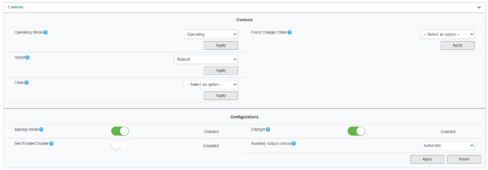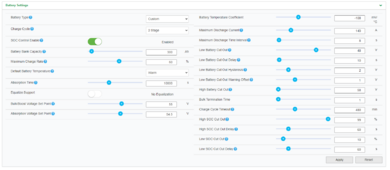Some new Information
I did some testing today and was able to sort out several issues.
About a week ago I changed my settings to use the SOC control. At one point I was having problems with SOC not being reliable. This could have been due to a bad connector cable. My SOC does not seem to have errors anymore after I worked on the cable connection.
I was having a problem when I allowed more than one string to operate at the same time. I thought this might have something to do with the "Max Charge Current" allowed. So I increased this setting from 15% to 60%. Mid summer in the worst case I have 9000 watts and the inverters will need to push about 170 amps into the batteries. With that change I was able to get all three strings to operate at the same time. The only down side is that the charging rate will increase after a power failure and the batteries will also charge quickly (around .5 or .6 C max depending on conditions) while using AC Coupling to recharge the batteries. The charging current will still get limited some by hitting the absorption or bulk voltage limit. It appears that the inverter is attempting to use those settings and Frequency / Watts to charge the battery as closely as possible to what it does during a normal AC charge. So next I turned the AC coupled function back on.
Once I had the strings staying on, I was surprised that they would charge all the way up to 100% even though I had set the Max AC Coupled value to 90%. I'm not sure the setting of the AC Coupled charging limit actually does anything. It appears that the frequency / watt function doesn't actually get triggered until the battery voltage exceeds the absorption volts.
Next I noticed that when the Schneider started to ramp up the frequency, the PV inverters did not back off until they all went to zero all at once. I updated my IEEE 1547 2015 profile to IEEE 1547 2018 instead. I heard the 2015 is all or nothing and 2018 does frequency / watts. It says this is the right profile to use in PA, if your system was installed after Jan 1, 2022 anyway so I really should be using that one. With that I actually get the Frequency / Watts to work. I did not yet update the Schneider with the 2018 profile. I probably should so the tow systems have the best possible compatibility. I tested this with a single string running. It appears that with one string the Schneider can easily manage the output with the Frequency / watts function. It appears that it actually looks at the charge voltage in the battery section of the configuration and will back the current off to keep the volts from exceeded the absorption value. Once the battery it totally full, if the frequency climbs high enough the PV shuts off completely.
Finally, I retested with all three strings running. At this point it was late afternoon and the array was no longer producing anywhere near the max power. I found that it would get the batteries full and then the taper back when Frequency / watts was applied. Eventually the voltage would get too high and all the strings would turn off.
So knowing what I now know, this my plan to make some adjustments. First, it appears there is now no reason to shed string three. I plan to wire this string to always stay on. Then I will shed string 2 based on the aux relay from inverter 1, and string 1 from the aux relay from inverter 2. The reason I give priority to string 3 is that it has panels that face both east and west. The other string are only west facing. I don't have the ideal roof for solar, but I do get good afternoon sun when i use the A/C in the summer. My winter production sucks.
I did notice that the ramp rate on the new profile is much more gradual. It takes about a minute for the panels to fully ramp up now (plus the 5 minutes before they even start to produce anything). It seemed like that ramp rate was removed from the old profile when Enphase did their firmware upgrade. So with the old profile everything turned on all at once. I don't think it used to do that. The current would spike and then everything shut down. Starting any of the panels up again then required power cycling the strings.
So now I would say that I have the AC coupling fully working. Even without my shedding box I don't think anything really bad would happen, but at mid-day I did notice that when all three strings turned on it would quickly push the voltage up to the point where all the panels would then quit. At least with the other changes I made, this was not a permanent shut down. After 5 minutes they would come on and run for 20-30 seconds and shut down again. Not very efficient for getting the batteries recharged. More batteries would probably solve this problem. My plan for now it to do some more testing to see at what point I should shed strings 1 and 2 to make sure the inverter can push the incoming current into the batteries without an overvoltage condition causing the frequency watts to turn all the PV off.
It might be a week or so before I have time to look at this again. For now I am happy. This was major progress.





